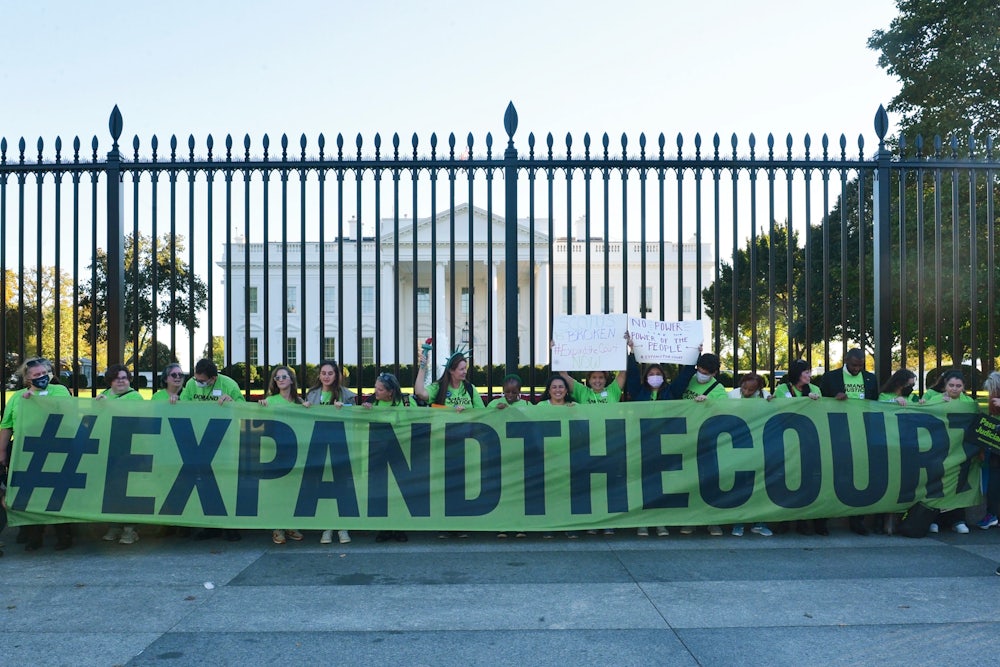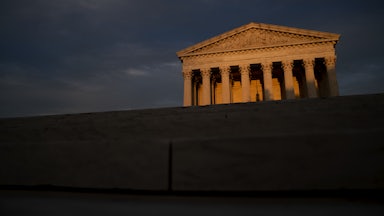In the unlikely event that President Joe Biden had been hoping his commission on Supreme Court reform would provide the intellectual and moral framework for court-packing, he will be sorely disappointed. The commission’s final report—or, well, a draft of the final report—includes no such calls for sweeping reforms. Its members instead compiled a range of opinions on potential reforms and provided some history for how the country got to this point.
If Biden hoped, on the other hand, that the commission’s final product would defuse and deflate court-packing sentiments among Democrats, then he will probably be happier with the outcome. The commission’s membership cast a wide ideological net within the American legal academy, all but guaranteeing that it wouldn’t end up endorsing such a radical change to the nation’s highest court. Even after some conservative members resigned from the body earlier this year, the commission moved no closer toward endorsing any substantive reforms.
The report lays out the pros and cons of various reform proposals, ranging from adding seats to the Supreme Court to imposing term limits on the justices, to a hodgepodge of inside-baseball aspects of the court’s work. Unlike the court itself, however, it rendered no final judgments. “As we noted at the outset … there is profound disagreement among Commissioners over whether adding Justices to the Supreme Court at this moment in time would be wise,” the report concluded. “As a Commission we have endeavored to articulate the contours of that debate as best as we understand them, without purporting to judge the weight of any of the arguments offered in favor or against calls to increase the size of the Court.”
One reform that apparently drew slightly less opposition among the commission’s members was the idea of imposing term limits on justices who currently have lifetime appointments. “The United States is the only major constitutional democracy in the world that has neither a retirement age nor a fixed term limit for its high court justices,” the report noted. “Among the world’s democracies, at least 27 have term limits for their constitutional courts. And those that do not have term limits, such as the Supreme Court of the United Kingdom, typically impose age limits.” Perhaps it’s no accident that the U.S. also has the oldest written Constitution still in use today; in the 1790s, the absence of modern medicine was the most effective term limit of all.
The commissioners nevertheless declined to endorse any specific plan even as they discussed the virtues and failings of each proposal—as well as the potential legality and constitutionality of some of them. Term limits would either require a constitutional amendment or a constitutionally dubious act of Congress. And even if enacted, the report noted, the reform could exacerbate some of the problems that the reform’s proponents hope to fix. “Opponents of term limits point out that if one of the failings of the current system is a bitterly partisan confirmation process, then prescribing yet more regular confirmation hearings, as term limits would, simply worsens an already bad situation,” the report observed.
That “bitterly partisan” process—and the ideological divide that it reifies and deepens—is referred to throughout the report. Indeed, it would be hard to discuss how the country got here without discussing the role that the political branches played in creating this problem. But Biden’s executive order to create the commission focused squarely on the Supreme Court itself, not on Congress. Accordingly, the commissioners explained that reforms of the confirmation process were beyond their remit: “We accordingly do not analyze or endorse any of the recommendations offered to us.” Though they excerpted some testimony from an expert on the confirmation process in an appendix, their consideration of possible reforms went no further than that.
Maybe that’s for the best, given the commission’s approach to the matter. In the end, it largely danced around the fact that court reformers are proposing structural solutions to nonstructural problems. The court still functions as it did two years ago or 200 years ago: It reviews cases from lower courts, it hears oral arguments on them, it issues decisions to resolve them. This is not the Senate, which defies the otherwise universal principle of “one person, one vote” in American legislative bodies with disastrous results. This is not the Electoral College, which was so poorly designed that the Framers had to rewrite it almost immediately and, even today, it occasionally elects a president who gets fewer votes than his opponent. The Supreme Court still “works,” so to speak.
What the court-packing proponents rightly fear is that the court is likely about to hand down decisions with which they disagree. Thanks to the aforementioned flaws in the Senate and the Electoral College, the Supreme Court’s current membership exists despite the will of the American electorate and not because of it. And thanks to a fairly effective judge-picking machine within the conservative legal movement, liberals have almost no reason for hope from the court for the next generation or so. But as I’ve pointed out from time to time, none of the court-packers’ proposals would actually be guaranteed to fix the problems that they identify—and some of their solutions would be more likely to make things much, much worse.










